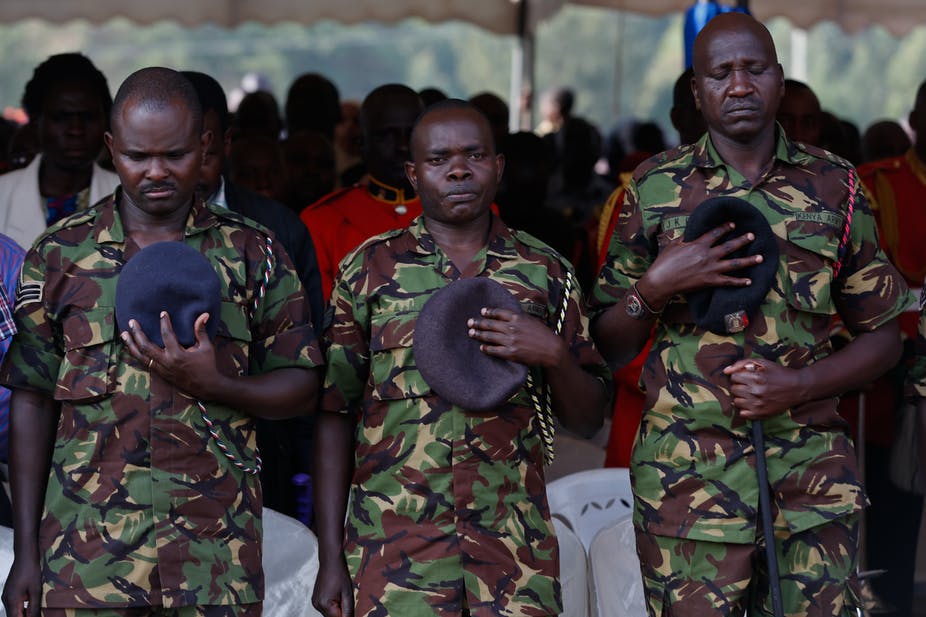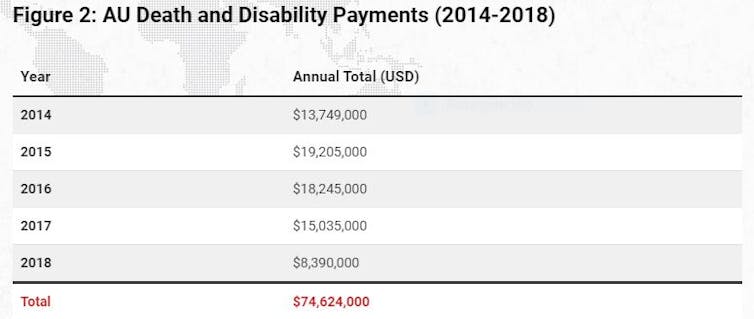For the first time, a reliable count of Somalia peacekeeping deaths

By Paul.D. Williams
The African Union (AU) leaves it to troop-contributing countries to release information about casualties in its peace operation in Somalia. To date, no country in the AU’s mission has publicly released a comprehensive list of their personnel killed in the battle against the al-Shabaab terror group.
I maintain that this is not a good policy for two main reasons. First, all peacekeepers who make the ultimate sacrifice should have their service publicly recognised. Not doing so is not only immoral – it is also likely to have a negative effect on morale.
Second, concealing peacekeeper deaths plays into al-Shabaab’s hands. The group is often able to dominate the media terrain in the absence of an authoritative and trusted AU or African Union Mission in Somalia (AMISOM) voice. Optimal strategic communications for a peace operation like this would involve the mission’s representatives becoming authoritative voices in the Somali media ecosystem.
My previous report in 2015 made clear that neither of the most widely used armed conflict databases – the Uppsala Conflict Data Program or the Armed Conflict Event and Location Data project – provided plausible numbers for AMISOM’s casualties.
I also wrote that it was unlikely, as some reports suggested, that AMISOM had lost “up to 3,000” or “perhaps over 4,000” peacekeepers.
New evidence has made possible a more accurate estimate of how many African personnel have died since the Somalia mission deployed in March 2007. This new evidence comes from my research into the mission, newly-released financial statements from the AU from 2014 to 2018, a new dataset listing attacks on peacekeepers, and a new listing of dead peacekeepers on the “Memorial Wall of Our Heroes” at the AU headquarters in Addis Ababa, Ethiopia.
Previous research combined with the new evidence suggests that a plausible estimate of AMISOM’s fatalities between March 2007 and December 2018 could be between 1,483 and 1,884.
New financial evidence
In March 2017 the AU released financial statements detailing the organisation’s spending between 2014 and 2017. In May 2019 it released the report for 2018. These financial reports include the death and disability grants paid by the AU to the mission’s troop-contributing governments which are currently Burundi, Djibouti, Ethiopia, Kenya and Uganda.
Agreements signed between the AU and these countries fixed the death compensation at $50,000. The compensation for disability would depend on the degree of injury or disabilities suffered. Funding for these payments came from the European Union, through its African Peace Facility.
Based on these payments, it can be gleaned that AMISOM suffered 439 fatalities between August 2009 and September 2012: 22 in 2009, 59 in 2010, 298 in 2011, and 60 in 2012. But there was also an additional $5,779,000 paid out in disability compensation, about $10,000 for each of the approximately 575 injured soldiers.
So, for the 37 months from August 2009 to September 2012, the AU spent $27,729,000 on death and disability compensation. Of this total, 79% was spent on death compensation and 21% on disability compensation.
It is in light of these insights that we should assess the death and disability compensation data provided in the newly released AU financial statements for 2014 through 2018. These public reports reveal that the AU paid $74,624,000 in death and disability compensation between 2014 and 2018.

If we assume a similar proportion of death and disability compensation in these payments as in those made between August 2009 and September 2012, this would mean 79% was spent on death compensation ($58,952,960) and 21% on disability compensation ($15,671,040). This would equate to approximately 1,179 payments of $50,000 for deceased personnel and 1,567 payments of $10,000 for injured personnel. In contrast, if we assumed a 50:50 split between fatality and injury payments, this would suggest 746 fatalities and 3,731 injured peacekeeper payments.
Following the money is a plausible but not foolproof way to estimate the number of casualties suffered. It is in each country’s interest to claim the compensation to which it is entitled – but it’s also possible that compensation payments were made to the governments other than via the AU.
The peacekeeper memorials
The inauguration of the “Memorial Wall of Our Heroes” in 2018 was an interesting development. It lists the names and ranks (but no dates) of peacekeepers who have died on AU-led and AU-authorised peace support operations.
These include operations in Burundi, Sudan, Central Africa Republic and Somalia. AU-authorised multinational operations against Boko Haram and in the Sahel also feature. As of August 2019, there were 1,108 names listed on the wall’s 19 columns.
The Somalia mission, too, has a memorial for its fallen personnel just outside its force headquarters in Mogadishu. However, it lists no names or numbers. Rather, its dedication reads:
In memory of the officers, men and women of the African Union Mission in Somalia (AMISOM), and the Somali National Security Forces (SNSF), who lost their lives in pursuit of peace and stability in Somalia.
So what?
There is now a reasonably plausible set of estimates for almost the entire period of AMISOM deployment between March 2007 and December 2018 derived from five sources.
- First, in my book, Fighting for Peace in Somalia, I cite an internal AMISOM briefing on February 25, 2009 which listed 12 fatalities and 25 injured peacekeepers as of December 10, 2008. I assume this is accurate since it was provided discreetly by the AU to the mission’s bilateral partners. The numbers are low, reflecting the fact that there was relatively little fighting during 2007 and 2008.
- Peacemakers at Risk dataset is the second source. For 2009, this estimates that 40 peacekeepers were killed in violent attacks. My research suggests that another six AMISOM peacekeepers died in 2009 from illness (4) and motor vehicle accidents (2), making a total of 46.
- A third source is the financial records between August 2009 and September 2012 discussed above, which revealed 439 fatalities. Twenty-two of those occurred between August and December 2009. This leaves 417 between January 2010 and September 2012.
- Fourth, the publicly released AU compensation payments plausibly suggest approximately 1,148 or 747 fatalities between 2014 and 2018.
- Finally, the SIPRI database on multilateral peace operations detailing fatalities between 2009 and 2014 had a figure of 261 fatalities for the 2013 calendar year.
Taken together, these sources cover most of the Somalia AU mission timeline, except a period of three-and-a-half months covering part of December 2008 and October to December 2012. But this represents a mere 2.5% of the entire deployment period.
Professor of International Affairs, George Washington University
A longer version of this article appeared in the IPI Global Observatory.